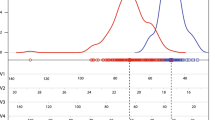Abstract
Points of view analysis (PVA), proposed by Tucker and Messick in 1963, was one of the first methods to deal explicitly with individual differences in multidimensional scaling, but at some point was apparently superceded by the weighted Euclidean model, well-known as the Carroll and Chang INDSCAL model. This paper argues that the idea behind points of view analysis deserves new attention, especially as a technique to analyze group differences. A procedure is proposed that can be viewed as a streamlined, integrated version of the Tucker and Messick Process, which consisted of a number of separate steps. At the same time, our procedure can be regarded as a particularly constrained weighted Euclidean model. While fitting the model, two types of nonlinear data transformations are feasible, either for given dissimilarities, or for variables from which the dissimilarities are derived. Various applications are discussed, where the two types of transformation can be mixed in the same analysis; a quadratic assignment framework is used to evaluate the results.
Similar content being viewed by others
References
Bloxom, B. (1978). Constrained multidimensional scaling in N spaces.Psychometrika, 43, 397–408.
Carroll, J. D., & Chang, J. J. (1970). Analysis of individual differences in multidimensional scaling via anN-way generalization of “Eckart-Young” decomposition.Psychometrika, 35, 283–319.
Cliff, N. (1968). The “idealized individual” interpretation of individual differences in multidimensional scaling.Psychometrika, 33, 225–232.
de Leeuw, J. (1988). Convergence of the majorization algorithm for multidimensional scaling.Journal of Classification, 5, 163–180.
de Leeuw, J., & Heiser, W. J. (1980). Multidimensional scaling with restrictions on the configuration. In P. R. Krisnaiah (Ed.),Multivariate analysis, Vol. V (pp. 501–522). Amsterdam: North-Holland.
De Soete, G., DeSarbo, W. S., & Carroll, J. D. (1985). Optimal variable weighting for hierarchical clustering: An alternative least-squares algorithm.Journal of Classification, 2, 173–192.
Escoufier, Y. (1973). Le traitement des variables vectorielles [The treatment of vector-valued variables].Biometrics, 29, 751–760.
Escoufier, Y. (1980). Exploratory data analysis when data are matrices. In K. Matusita (Ed.),Recent developments in statistical inference and data analysis (pp. 45–53). Amsterdam: North-Holland.
Escoufier, Y. (1988). Beyond correspondence analysis. In H. H. Bock (Ed.),Classification and related methods of data analysis (pp. 505–514). Amsterdam: North-Holland.
Gifi, A. (1990).Nonlinear multivariate analysis. Chichester: Wiley. (First edition 1981, Leiden: The University of Leiden, Department of Data Theory)
Gower, J. C. (1971). A general coefficient of similarity and some of its properties.Biometrics, 27, 857–871.
Guttman, L. (1968). A general nonmetric technique for finding the smallest coordinate space for a configuration of points.Psychometrika, 33, 469–506.
Heiser, W. J., & Stoop, I. (1986).Explicit SMACOF algorithms for individual differences scaling (Research Report RR-86-14). Leiden: Department of Data Theory.
Horan, C. B. (1969). Multidimensional scaling: Combining observations when individuals have different perceptual structures.Psychometrika, 34, 139–165.
Hubert, L. J. (1987).Assignment methods in combinatorial data analysis. New York: Marcel Dekker.
Jones, C. L. (1983). A note on the use of directional statistics in weighted Euclidean distances multidimensional scaling models.Psychometrika, 48, 473–476.
Kiers, H. A. L. (1989).Three-way methods for the analysis of qualitative and quantitative two-way data. Leiden: DSWO Press.
Kruskal, J. B. (1964a). Multidimensional scaling by optimizing goodness of fit to a nonmetric hypothesis.Psychometrika, 29, 1–28.
Kruskal, J. B. (1964b). Nonmetric multidimensional scaling: A numerical method.Psychometrika, 29, 115–129.
Kruskal, J. B., Young, F. W., & Seery, J. B. (1973).How to use KYST, a very flexible program to do multidimensional scaling and unfolding. Murray Hill: Bell Laboratories.
Meulman, J. J. (1986).A distance approach to nonlinear multivariate analysis. Leiden: DSWO Press.
Meulman, J. J. (1992). The integration of multidimensional scaling and multivariate analysis with optimal transformations.Psychometrika, 57, 539–565.
Ramsay, J. O. (1982a). Some statistical approaches to multidimensional scaling data.Journal of the Royal Statistical Society, Series A, 145, 285–312.
Ramsay, J. O. (1982b).MULTISCALE II manual. Montréal: McGill University, Department of Psychology.
Ramsay, J. O. (1989). Monotone regression splines in action.Statistical Science, 4, 425–441.
Ross, J. (1966). A remark on Tucker and Messick's “Points of view” analysis.Psychometrika, 31, 27–32.
Saporta, G. (1975). Pondération optimale de variables qualitatives en analyse des données [Optimal weighting of qualitative variables in ‘analyse des données’].Statistique et Analyse des Données, 3, 19–31.
Shepard, R. N. (1962a). The analysis of proximities: Multidimensional scaling with an unknown distance function. I.Psychometrika, 27, 125–140.
Shepard, R. N. (1962b). The analysis of proximities: Multidimensional scaling with an unknown distance function. II.Psychometrika, 27, 219–246.
Schiffman, S. S., Reynolds, M. L., & Young, F. W. (1981).Introduction to multidimensional scaling. New York: Academic Press.
Tucker, L. R. (1951).A method of synthesis of factor analysis studies (Personnel Research Section Report No. 984). Washington, D. C.: Department of the Army.
Tucker, L. R., & Messick, S. (1963). An individual differences model for multidimensional scaling.Psychometrika, 28, 333–367.
Verboon, P., & van der Kloot, W. A. (1989).On the relation between INDSCAL and nonlinear points of view analysis (Research Report PRM-89-02). Leiden: University of Leiden, Department of Psychometrics.
Winsberg, S., & De Soete, G. (in press).A latent class approach to fitting the INDSCAL model. Psychometrika.
Winsberg, S., & Ramsay, J. O. (1983). Monotone spline transformations for dimension reduction.Psychometrika, 48, 575–595.
Zegers, F. E., & ten Berge, J. M. F. (1985). A family of association coefficients for metric scales.Psychometrika, 50, 17–24.
Author information
Authors and Affiliations
Additional information
The research of the first author was supported by the Royal Netherlands Academy of Arts and Sciences (KNAW); the research of the second author by the Netherlands Organization for Scientific Research (NWO Grant 560-267-029). An earlier version of this paper was presented at the European Meeting of the Psychometric Society, Leuven, 1989. We wish to thank Willem J. Heiser for his stimulating comments to earlier versions of this paper, and we are grateful to the Editor and anonymous referees for their helpful suggestions.
Rights and permissions
About this article
Cite this article
Meulman, J.J., Verboon, P. Points of view analysis revisited: Fitting multidimensional structures to optimal distance components with cluster restrictions on the variables. Psychometrika 58, 7–35 (1993). https://doi.org/10.1007/BF02294468
Received:
Revised:
Issue Date:
DOI: https://doi.org/10.1007/BF02294468




